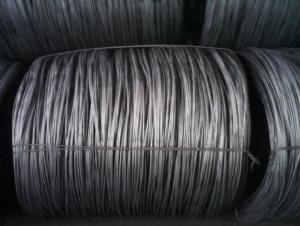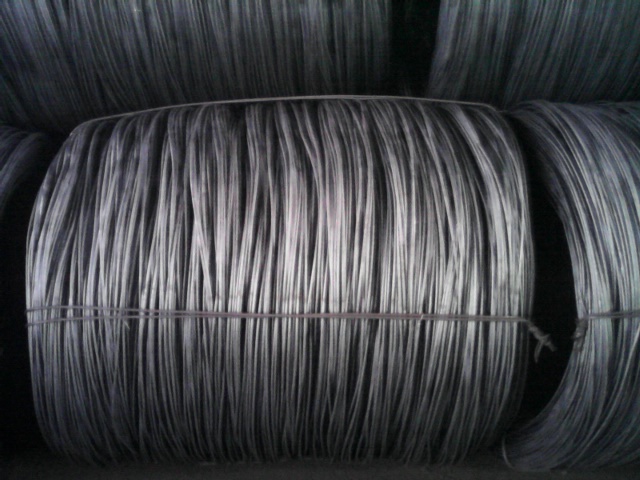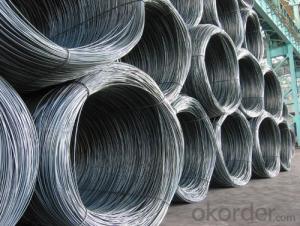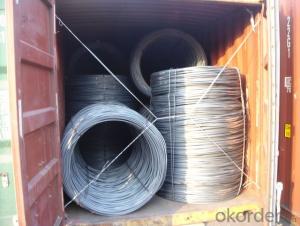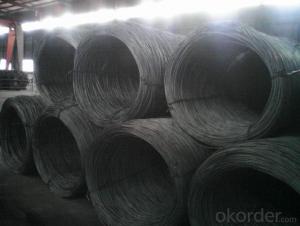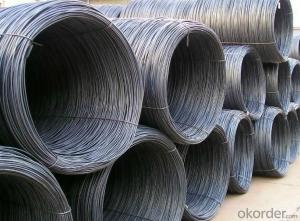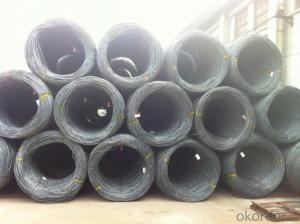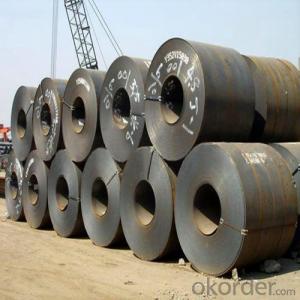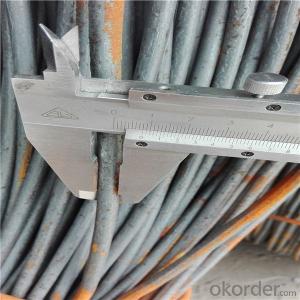Hot Rolled High Quality Wire Rod Coil
- Loading Port:
- China Main Port
- Payment Terms:
- TT or LC
- Min Order Qty:
- -
- Supply Capability:
- -
OKorder Service Pledge
OKorder Financial Service
You Might Also Like
Product Description:
OKorder is offering Wire Rod at great prices with worldwide shipping. Our supplier is a world-class manufacturer of steel, with our products utilized the world over. OKorder annually supplies products to European, North American and Asian markets. We provide quotations within 24 hours of receiving an inquiry and guarantee competitive prices.
Product Applications:
After hot-rolled the products shaped into coil and delivery as finished product, including round, square, rectangular, hexagonal and so on. Since most of the products are round, it is generally called wire rod. Carbon steel wire rod is widely used in construction and manufacturing. Carbon steel wire rod is mainly used for reinforcement of reinforced concrete and welded structure or reprocessed (roberts , nail, etc.) materials, especially used to produce wire drawing, welding electrode, nails, spring, electronic, precise machinery parts and so on.
Product Advantages:
OKorder's Wire Rod are durable, strong, and resist corrosion.
Main Product Features:
· Premium quality
· Prompt delivery & seaworthy packing (30 days after receiving deposit)
· Corrosion resistance
· Can be recycled and reused
· Mill test certification
· Professional Service
· Competitive pricing
Product Specifications:
Steel Grade: Q195/235, SAE1006-1018B Standard: ASTM, GB
Diameter: 5.5mm, 6.5mm, 7mm,8mm,9mm,10mm,12mm,14mm
Type: in coil, coil weight around 2MT Alloy or Not: Alloy
Surface: round, no twisted, light and smooth Chemical Composition: (Please kindly find our chemistry of our material based on Q195、Q235A and Q235B as below for your information)
Grade | Chemical Composition (%) | |||||
C | Mn | S | P | Si | B | |
SAE1008B | 0.10max | 0.32max | 0.045max | 0.040max | 0.30max | 0.0008min |
Mechanical properties | ||||||
Yield strength(N/mm2) | Tensile strength(N/mm2) | Elongation (%) | ||||
≥195 | 350-380 | ≥32 | ||||
Packaging & Delivery of Carbon Steel Wire Rod:
Packaging Detail: products are packed in coil, each coil weight around 2 MT, and then shipped by container or bulk vessel
Delivery Detail: within 45 days after received deposit or LC.
Label: to be specified by customer, generally, each bundle has 1-2 labels
Trade terms: FOB, CFR, CIF
FAQ:
Q1: How soon can we receive the product after purchase?
A1: Within three days of placing an order, we will begin production. The specific shipping date is dependent upon international and government factors, but is typically 7 to 10 workdays.
Q2: What makes stainless steel stainless?
A2: Stainless steel must contain at least 10.5 % chromium. It is this element that reacts with the oxygen in the air to form a complex chrome-oxide surface layer that is invisible but strong enough to prevent further oxygen from "staining" (rusting) the surface. Higher levels of chromium and the addition of other alloying elements such as nickel and molybdenum enhance this surface layer and improve the corrosion resistance of the stainless material.
Q3: Can stainless steel rust?
A3: Stainless does not "rust" as you think of regular steel rusting with a red oxide on the surface that flakes off. If you see red rust it is probably due to some iron particles that have contaminated the surface of the stainless steel and it is these iron particles that are rusting. Look at the source of the rusting and see if you can remove it from the surface.
Images:
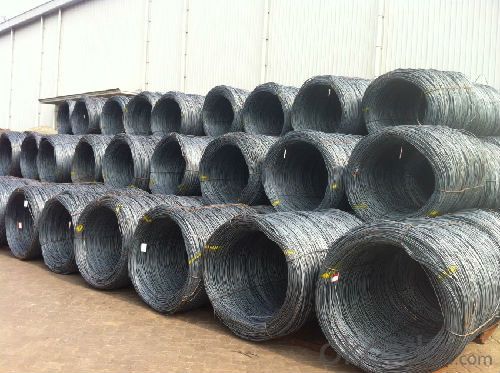
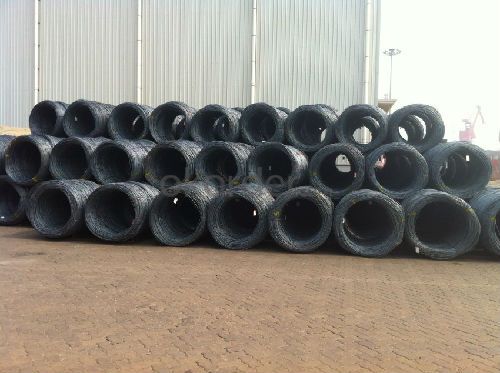
- Q: What are the different wear testing methods for steel wire rod?
- There are several different wear testing methods that can be used to evaluate the performance of steel wire rods. These methods are designed to simulate real-world conditions and assess the durability and wear resistance of the wire rods. Here are some of the commonly used wear testing methods for steel wire rods: 1. Pin-on-Disk Test: In this method, a pin-shaped sample of the steel wire rod is pressed against a rotating disk under controlled conditions. The wear and frictional properties of the wire rod can be measured by analyzing the wear scar on the disk. 2. Ball-on-Disk Test: Similar to the pin-on-disk test, this method involves placing a steel ball on a rotating disk. The wear and frictional behavior of the wire rod can be evaluated by measuring the wear scar on the disk caused by the interaction between the ball and the rod. 3. Abrasion Testing: This method involves subjecting the steel wire rod to abrasive conditions to evaluate its resistance to wear. The wire rod can be tested using methods such as the Taber abrasion test or the ASTM G65 test, where the rod is rubbed against an abrasive material or surface. 4. Sliding Wear Test: This test simulates the sliding motion between two surfaces. The steel wire rod is typically placed against a counter surface, and a controlled force is applied while the surfaces slide against each other. The wear and frictional properties of the wire rod can be measured based on the wear scar on the counter surface. 5. Wear Simulation in Real Applications: In some cases, wear testing can be performed by subjecting the steel wire rod to the actual application conditions. This could involve using the wire rod in a specific machinery or equipment, and then evaluating its wear resistance based on the observed wear and performance. These different wear testing methods enable researchers and manufacturers to assess the wear resistance and durability of steel wire rods under various conditions. By understanding how the wire rod performs in different wear scenarios, improvements can be made to the material composition or manufacturing processes to enhance its wear resistance and overall performance.
- Q: What are the main uses of steel wire rod?
- Steel wire rod is primarily used in the construction industry for various applications such as reinforcing concrete structures, manufacturing wire mesh, and producing steel cables and wires. It is also used in the automotive industry for making springs, suspension systems, and other components that require high-strength materials. Additionally, steel wire rod finds utility in the manufacturing of nails, screws, and other fasteners, as well as in the production of electrical wires and cables.
- Q: How is steel wire rod used in the production of wire brushes?
- Steel wire rod is used in the production of wire brushes as it serves as the main material for the bristles. The wire rod is shaped, cut, and twisted to create the bristles that are then attached to the brush's base or handle. The strength and durability of steel wire make it ideal for wire brushes, allowing them to effectively remove dirt, debris, and rust from various surfaces.
- Q: What are the common warranty considerations for steel wire rod?
- The common warranty considerations for steel wire rod typically include factors such as the quality of the material, compliance with industry standards, and the intended use of the rod. Other considerations may include the manufacturing process, any specific certifications or testing conducted, and the seller's reputation or track record in the industry. It is important to thoroughly review the warranty terms and conditions provided by the manufacturer or supplier to ensure that they meet the specific requirements and expectations for the steel wire rod.
- Q: How is steel wire rod used in the manufacturing of wire forms for communication cables?
- Steel wire rod plays a vital role in the manufacturing process of wire forms for communication cables. It serves as the foundational material from which wires are derived. Once obtained, the steel wire rod goes through a sequence of procedures to transform it into wire forms suitable for communication cables. To begin with, the steel wire rod is thoroughly cleansed and inspected to identify any defects or impurities. This guarantees that the resulting wire forms meet the required standards and are of the utmost quality. Once cleansed, the steel wire rod is heated to a specific temperature and passed through a set of dies. This process, referred to as drawing, reduces the diameter of the wire rod while increasing its length. Subsequent to the drawing process, the steel wire rod undergoes further processing to enhance its mechanical properties. This may involve annealing, a heat treatment method that enhances the wire's flexibility and reduces its brittleness. Additionally, the wire may undergo various surface treatments to augment its resistance to corrosion or provide insulation. Once the wire forms are manufactured, they are utilized in the production of communication cables. These wire forms can function as conductive elements within the cables, enabling the transmission of electrical signals. Moreover, the wire forms can be utilized as structural components, imparting strength and support to the cables. In the manufacturing of communication cables, the steel wire rod guarantees the production of high-quality wire forms that meet the specific requirements of these cables. The durability, flexibility, and conductivity of the wire forms contribute to the efficient and reliable transmission of information through the communication cables.
- Q: What are the safety requirements for steel wire rod used in elevator wire ropes?
- The safety requirements for steel wire rod used in elevator wire ropes include factors such as the wire's tensile strength, flexibility, fatigue resistance, and corrosion resistance. It should meet industry standards and be able to withstand the weight and stress placed on it during elevator operation. Additionally, the wire rod should be properly tested and certified for its quality and performance to ensure the safety of elevator passengers and operators.
- Q: What are the different testing methods for steel wire rod?
- Steel wire rods can be evaluated for quality and characteristics using various testing methods. Common methods include: 1. Tensile Testing: The steel wire rod is subjected to tension until it breaks, allowing for the measurement of its maximum load-bearing capacity and providing information on tensile strength, yield strength, and elongation. 2. Bend Testing: The steel wire rod is bent to a specific angle and examined for cracks or fractures, assessing its ductility and resistance to deformation. 3. Hardness Testing: The hardness of the steel wire rod is measured using techniques like Rockwell, Brinell, or Vickers hardness tests. This determines the rod's ability to resist indentation or penetration. 4. Microscopic Examination: The microstructure of the steel wire rod is examined under a microscope to assess grain size, inclusion content, and overall quality. 5. Chemical Analysis: The chemical composition of the steel wire rod is analyzed to ensure it meets required specifications and standards. 6. Ultrasonic Testing: High-frequency sound waves are used in this non-destructive testing method to detect internal flaws or defects in the steel wire rod, assessing its integrity and identifying potential weaknesses. 7. Dimensional Inspection: Physical dimensions of the steel wire rod are measured to ensure they meet specified tolerances and requirements. By employing these testing methods, manufacturers and quality control personnel can ensure that steel wire rods meet necessary standards for their intended applications.
- Q: What are the different types of steel wire rod surface cleaning methods for wire drawing?
- There are several types of steel wire rod surface cleaning methods for wire drawing. These include mechanical cleaning, chemical cleaning, and electrolytic cleaning. Mechanical cleaning involves the use of brushes, abrasive pads, or shot blasting to remove dirt, rust, and scale from the surface of the wire rod. Chemical cleaning involves the use of acids or alkaline solutions to remove contaminants and oxide layers from the surface. Electrolytic cleaning uses an electric current to dissolve and remove impurities from the wire rod surface. Each method has its advantages and suitability depending on the specific requirements of the wire drawing process.
- Q: How is the surface quality of steel wire rod evaluated?
- The surface quality of steel wire rod is evaluated by visually inspecting for any defects or imperfections on the surface, such as scratches, pits, cracks, or other surface irregularities. Additionally, the rod may undergo non-destructive testing methods like magnetic particle inspection or ultrasonic testing to identify any hidden flaws or internal defects.
- Q: How is steel wire rod used in the manufacturing of suspension systems for vehicles?
- Steel wire rod is commonly used in the manufacturing of suspension systems for vehicles due to its high strength and flexibility. It is typically formed into coil springs, torsion bars, or stabilizer bars that help absorb shocks and vibrations, ensuring a smooth and stable ride. The steel wire rod's durability and ability to withstand heavy loads make it a reliable component in suspension systems, providing support and enhancing the overall performance and safety of vehicles.
Send your message to us
Hot Rolled High Quality Wire Rod Coil
- Loading Port:
- China Main Port
- Payment Terms:
- TT or LC
- Min Order Qty:
- -
- Supply Capability:
- -
OKorder Service Pledge
OKorder Financial Service
Similar products
Hot products
Hot Searches
Related keywords
